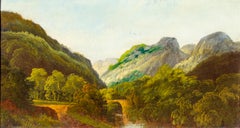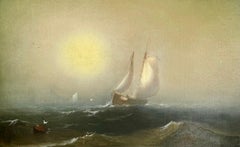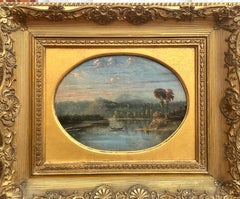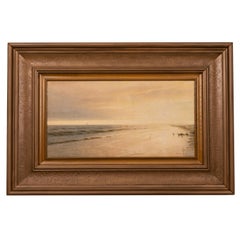Hudson River School Art
Considered the first major American painting movement, the Hudson River School emerged in the first half of the 19th century with landscape paintings that celebrated the young country’s natural beauty. Most of its leading painters were based in New York City where they exchanged ideas and traveled to the nearby Hudson River Valley and Catskills Mountains to re-create their vistas. At a time when the city was increasingly dense, the Hudson River School artists extolled the vast and pristine qualities of the American landscape, a sentiment that would inform the conservation movement.
American art was dominated by portraiture and historical scenes before Thomas Cole, the founder of the Hudson River School, began painting the Catskill Mountains in 1825. While the Hudson River School was informed by European art aesthetics, particularly the British focus on the sublime in nature, it was a style imbued with nationalism. The landscape painters who followed and studied under Cole would expand their focus from the Northeastern United States to places across the country, their work shared through prints and portfolios promoting an appreciation for the American wilderness — Niagara Falls, the mountain ranges that dot the American West and more — as the style blossomed during the mid-19th century.
Cole’s student Frederic Edwin Church as well as painters such as Albert Bierstadt, John Frederick Kensett, Asher Brown Durand and others became prominent proponents of the Hudson River School. The American art movement also had close ties to the literary world, including to authors like William Cullen Bryant, Henry David Thoreau and James Fenimore Cooper who wrote on similar themes. Although by the early 1900s the style had waned, and modernism would soon guide the following decades of art in the United States, the Hudson River School received renewed interest in the late 20th century for the dramatic way its artists portrayed the world.
Find a collection of authentic Hudson River School paintings, drawings and watercolors and more art on 1stDibs.
Early 20th Century Hudson River School Art
Oil, Canvas
1880s Hudson River School Art
Canvas, Oil
1870s Hudson River School Art
Canvas, Oil
1870s Hudson River School Art
Oil
Mid-19th Century Hudson River School Art
Canvas, Oil
1870s Hudson River School Art
Paper, Watercolor
Mid-19th Century Hudson River School Art
Oil, Laid Paper
Early 20th Century Hudson River School Art
Canvas, Oil, Stretcher Bars
1870s Hudson River School Art
Canvas, Oil
19th Century Hudson River School Art
Oil
1950s Hudson River School Art
Oil, Linen, Stretcher Bars
Late 19th Century Hudson River School Art
Canvas, Oil
Late 19th Century Hudson River School Art
Canvas, Oil
Late 19th Century Hudson River School Art
Canvas, Oil
2010s Hudson River School Art
Oil, Canvas
1870s Hudson River School Art
Pastel, Archival Paper
21st Century and Contemporary Hudson River School Art
Canvas, Oil, Illustration Board
1840s Hudson River School Art
Watercolor, Laid Paper, Lithograph
19th Century Hudson River School Art
Canvas, Oil
19th Century Hudson River School Art
Canvas, Oil
19th Century Hudson River School Art
Canvas, Oil
Mid-19th Century Hudson River School Art
Oil, Canvas
1890s Hudson River School Art
Oil, Canvas
1880s Hudson River School Art
Oil, Board
1890s Hudson River School Art
Oil
Mid-19th Century Hudson River School Art
Oil, Panel
Mid-19th Century Hudson River School Art
Gold Leaf
1870s Hudson River School Art
Oil
1870s Hudson River School Art
Canvas, Oil
1870s Hudson River School Art
Canvas, Oil
Early 20th Century Hudson River School Art
Canvas, Oil
Late 19th Century Hudson River School Art
Canvas, Oil
1870s Hudson River School Art
Woodcut
Late 19th Century Hudson River School Art
Oil, Canvas
19th Century Hudson River School Art
Oil
Early 20th Century Hudson River School Art
Oil, Board
1920s Hudson River School Art
Canvas, Oil, Stretcher Bars
Mid-19th Century Hudson River School Art
Canvas, Oil
19th Century Hudson River School Art
Canvas, Oil
Late 19th Century Hudson River School Art
Oil, Board
1850s Hudson River School Art
Canvas, Oil
1890s Hudson River School Art
Oil, Board
Late 19th Century Hudson River School Art
Canvas, Oil
1890s Hudson River School Art
Canvas, Oil
Mid-19th Century Hudson River School Art
Canvas, Oil
Mid-19th Century Hudson River School Art
Canvas, Oil
Early 20th Century Hudson River School Art
Watercolor
1890s Hudson River School Art
Canvas, Oil
Late 19th Century Hudson River School Art
Oil, Board
19th Century Hudson River School Art
Oil, Board
19th Century Hudson River School Art
Canvas, Oil
Late 19th Century Hudson River School Art
Oil, Board
Early 19th Century Hudson River School Art
Oil, Panel
Mid-19th Century Hudson River School Art
Canvas, Oil
Late 19th Century Hudson River School Art
Oil, Panel
19th Century Hudson River School Art
Canvas, Oil
Late 19th Century Hudson River School Art
Wood, Oil
Mid-19th Century Hudson River School Art
Canvas, Oil
Mid-19th Century Hudson River School Art
Canvas, Oil
19th Century Hudson River School Art
Oil, Board




